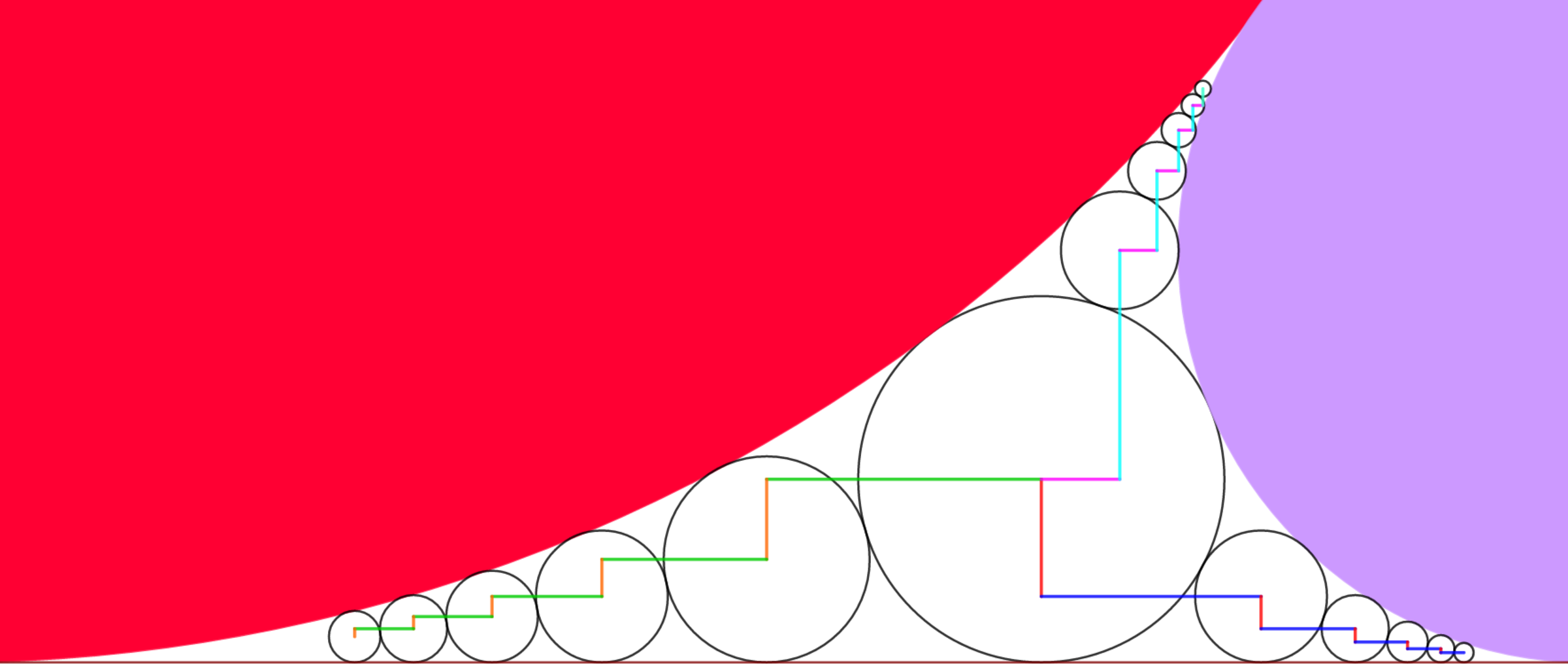Descartes Sangaku :The stairway part 2
- The diagram shows a red circle with radius 2 1 and a purple circle with radius 8 1 tangent to each other and mutually tangent to the same brown line
- We inscribe a circle between the brown line, the red circle and the purple circle.
- Then we pack the space with circles to the left, to the right and to the top.
- At last we build 3 stairways by connecting the center of consecutive circles ; consecutive stairs are perpendicular to each other.
- We consider the stairway built to the left side of the diagram. This stairway is composed of orange vertical lines and green horizontal lines.
- The n t h orange vertical line is denoted as V n .
- The n t h green horizontal line is denoted as H n .
The question: Evaluate : ∑ n = 5 0 6 0 V n ∑ n = 5 0 6 0 H n , for n ≥ 1 the answer can be expressed as b a where a and b are coprime positive integers. Calculate a − b

The answer is 6437.
This section requires Javascript.
You are seeing this because something didn't load right. We suggest you, (a) try
refreshing the page, (b) enabling javascript if it is disabled on your browser and,
finally, (c)
loading the
non-javascript version of this page
. We're sorry about the hassle.
1 solution
- First, let's calculate the sequence of radii of consecutive circles on the left side, starting from the central black circle. Using Descartes Circle's Theorem, we get the 6 first radii of the sequence:
- 1 8 1
- 3 2 1
- 5 0 1
- 7 2 1
- 9 8 1
- 1 2 8 1
- We notice that the numerator stays the same, and we can substract the consecutive denominators and identify a pattern :
- 3 2 − 1 8 = 1 0 + 4 ⋅ 1
- 5 0 − 3 2 = 1 0 + 4 ⋅ 2
- 7 2 − 5 0 = 1 0 + 4 ⋅ 3
- 9 8 − 7 2 = 1 0 + 4 ⋅ 4
- 1 2 8 − 9 8 = 1 0 + 4 ⋅ 5
- We can conclude : R n = 2 n 2 + 8 n + 8 1
- Now, we notice that we can make a right triangle by using the center of two consecutive circles. Joining their center makes the hypothenuse, the orange and green lines are the legs of the triangle. This allows use to write this pythagorean equality:
- ( R n + R n + 1 ) 2 = V n 2 + H n 2
- Since the circles of the consider sequence lie on the same line we can write ( R n − R n + 1 ) = V n
- ( R n + R n + 1 ) 2 = ( R n − R n + 1 ) 2 + H n 2
- Using the last result : R n = 2 n 2 + 8 n + 8 1 and after doing some algebra we find:
- H n = ( n + 2 ) ( n + 3 ) 1
- V n = 2 ( n + 2 ) 2 ( n + 3 ) 2 2 n + 5
- ∑ n = 5 0 6 0 V n ∑ n = 5 0 6 0 H n = 1 1 5 6 5 5 2
- a − b = 6 5 5 2 − 1 1 5 = 6 4 3 7